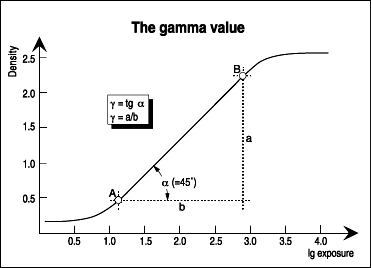
Gamma
In Film: A measurement of development contrast.
Electronic: “The exponent of that power law that is used to approximate the curve of output magnitude versus input magnitude over the region of interest” [IEEE 100].
Contrast in photographic processes can be influenced in a few ways. First of all the initial exposure will influence the final result, but between them come the speed of the photographic emulsion, type of developer, length of time spent in development.
Subsequent copies also have their contrast affected by the same factors. In order to standardize and cut out the guess work the materials (film and developer) have been tested together under all combinations of exposure, time and temperature.
The optimum development time and temperature for an average contrast worked out and represented in the form of a characteristic curve. This is simply a curve relating exposure to the density of the image under stated conditions of development.
‘Gamma’ in the photographic sense was originally applied specifically to the straight-line portion of the transfer function. Only if all of the photographic densities corresponding to light intensities in the scene lie within that straight-line portion of the transfer function is gamma proportional to contrast.

Gamma is the slope of the substantially straight portion of the characteristic curve.
Gamma (electronic)
1. “The exponent of that power law that is used to approximate the curve of output magnitude versus input magnitude over the region of interest” [IEEE 100].
2. (video) “The power function of the electro gun in a CRT” (IEEE 100]
3. (video) It has become customary in video, as in photography, to extend the meaning and to use gamma as a synonym for the complete transfer function regardless of curve shape. Note – In the electronics system, increasing gamma decreases image contrast.
4. (imaging processing and display) Nonlinear processing is useful in many television systems as a means of bandwidth limiting, and is normally applied at the camera. Given the predominance of CRT displays, the chosen exponent is related to that of the electron gun (typically 2.2 for systems with 525/59.94 scanning, 2.8 for systems with 625/50 scanning, and 2.22 for SMPTE 240M).
5. The transfer functions in actual use with current television systems depart from a pure power law function, making expedient changes including the addition of a constant to offset the curve, but they remain loosely called “power law functions.”
6. The inverse function is applied at the camera, producing a gamma corrected signal throughout most of the electronic environment.
Gamma correction
1. (video) Historically, gamma correction was a pre-compensation applied to the video signal at the camera to correct for the nonlinearities of the CRT (i.e., power function of the electron gun) and, as such, it was the inverse of the electron gun function.
2. It is now widely used, however, to describe “the total of all transfer function manipulations” (i.e., including the departures from a true power law function), whether inherent or intentionally introduced to act upon the video signal for the purpose of reducing the bandwidth for signal processing, making the image on the final display conform to preconceived artistic objectives, and/or providing noise suppression, or even bit-rate reduction.
3. “The insertion of a nonlinear output-input characteristic for the purpose of changing the system transfer characteristic” [IEEE 100]. As this usage has grown, the IEEE definition correlating gamma to an analytical function becomes optimistic.
Gamma table
A table of constants which functions as a non-linear amplifier to correct the electron gun drive voltages so that the CRT display appears to be linear. Because the gamma function for each color is different in a typical CRT, different values for each color are usually contained in the gamma table. This process is called gamma correction.
The National Film and Sound Archive of Australia acknowledges Australia’s Aboriginal and Torres Strait Islander peoples as the Traditional Custodians of the land on which we work and live and gives respect to their Elders both past and present.


